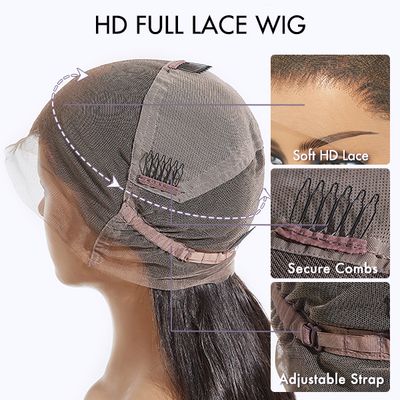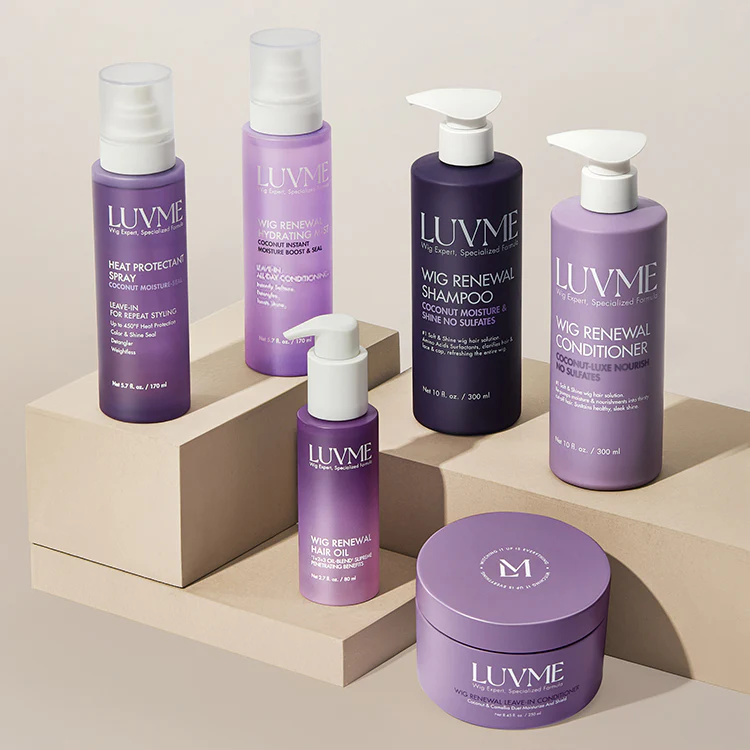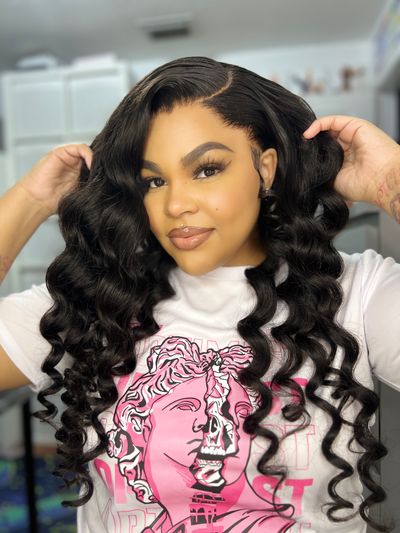Top Tips for Maintaining Glueless Full Lace Wigs

Everyone is using a wig nowadays. Celebrity hair styling, disguising, clinical concealing, or anything you name it, and a wig will be on the top of your head. There are synthetic hair wigs and natural human hair wigs, but it will not matter if they do not fit tight on the top of your head. People become a laughing stock if a wig falls off the head in public gatherings. This is the very reason why we must focus more on the fittings and size of the wigs first than the color and style of the wig.
Wig caps are the base on which the hair strands are grafted by the follicles and are made into suitable false hairs. The wig caps are mainly classified into the placement of the lace on the hair cap. The main categories are lace front hair wigs and full lace hair wigs.
The lace front wigs The front laced hair wigs are made from synthetic lacings affixed at the frontal linings of the wig cap. The lace is streamlined with perfection and it holds the cap tight over the forehead granting an affluent fake hairline to the wearer. Synthetic, silky, and wavy front laced wigs are sewn and knitted in the industrial setup and are usually 3” wide stripes of clothing braced on the netted cap. The lace is sometimes stretched and clipped behind the ears while at other times it is glued to the forehead and combed a mid-part to grant a flawless frontal hairline. Pros of lace front wigs
These are less expensive.
Grants you a sumptuous and healthy natural-looking hairline. Cons of lace frontal wigs
The wigs are stable at the front but loose at the back, thus any kind of back end hairstyle is off the menu.
The wigs cannot be mid parted or side-parted due to inadequate gripping.
3 Cap constructions for wigs
The full lace wigs The fully laced hair caps are the best kind of wigs. The wig is composed of a whole-headed medicated cap, dense follicle number, and a circumference all-around lacing. The lace is made up of breathable and unique material that holds the wig on the head with assurance and comfort. Pros of full lace wigs
The wigs are strongly placed over the head.
The hairs on the wigs could be parted according to your styling wish.
Due to the all-around grip of the lace, the wig is open to all back-end hairstyling like the top knot, the bun, or the high ponytail.
Twisting out is feasible with full lace wigs. Cons of full lace wigs
The only drawback of full lace wigs is they are quite costly because these are mainly handcrafted and are done with the best materials.
There are mainly two types of full lace wigs:
Glued - The wigs are held on the head by using glued under the lacing.
Glueless full lace wigs – These are the very best kind of wigs. To fit the head, the wig comes with an adjustable back end, somewhat elastic, straps, frontal combs, side combs, and stretchable lace clippers behind the ears. Some people may have rashes from using glue but with these arrangements, no side effects are found valid.
Glueless full lace wigs have gained popularity for their natural look and ease of use. These wigs, such as those offered by Luvmeforyou, eliminate the need for adhesive, making them a healthier option for the scalp. Proper maintenance of glueless full lace human hair wigs ensures longevity and keeps them looking fresh. Regular care routines, including cleaning and conditioning, are essential. Experts recommend professional help for deep cleaning or complex styling to maintain the wig's quality. Following these tips will help users enjoy beautiful, long-lasting wigs.
Refresh glueless full lace wigs with a spritz of leave-in conditioner or detangling spray every 30 minutes to prevent tangling and allow smooth movement. Periodic cleaning is essential for maintaining glueless lace wigs, and washing them helps keep them tidy and appealing. Store glueless wigs on a wig stand or mannequin head when not in use to maintain their shape, or gently fold and store them in a breathable bag. When washing glueless wigs, use a shampoo and conditioner specifically designed for wigs that are gentle and sulfate-free, and avoid scrubbing too hard to prevent damage. Brush or comb glueless wigs gently with a wide-tooth comb to remove tangles and prevent matting, while avoiding excessive pulling or tugging to protect the lace and hair. Use a satin or silk pillowcase to sleep on to reduce friction and prevent tangling or damage to glueless wigs. Apply a small amount of conditioner to the wig, avoiding the lace area, and let it sit for a few minutes to moisturize the hair. Dampen a small towel with shampoo and gently wipe the lace of glueless wigs to clean it, ensuring a slow and soft cleaning process to avoid damaging the delicate lace material.
Understanding Glueless Full Lace Wigs
What Are Glueless Full Lace Wigs?
Definition and Features
Glueless full lace wigs are designed for easy wear without the need for adhesive. These wigs feature a lace cap that covers the entire head, providing a natural look. The lace material is breathable, ensuring comfort for the wearer. Adjustable straps, combs, and elastic bands help secure the wig in place.
Benefits of Glueless Full Lace Wigs
Glueless full lace wigs offer several benefits. The absence of glue reduces the risk of scalp irritation. The adjustable features allow for a customizable fit. These wigs provide versatility in styling, enabling users to part the hair in any direction. The breathable lace material ensures comfort during extended wear.
Types of Glueless Full Lace Wigs
Full Lace vs. Lace Front
Full lace wigs cover the entire head with lace, allowing for versatile styling options. Lace front wigs have lace only at the front, providing a natural hairline but limiting styling flexibility. Full lace wigs offer more versatility but are generally more expensive than lace front wigs.
Human Hair vs. Synthetic
Glueless full lace human hair wigs provide a natural appearance and can be styled with heat tools. These wigs require more maintenance but offer a realistic look. Synthetic wigs are more affordable and require less upkeep. However, synthetic wigs lack the natural feel and styling flexibility of human hair wigs.
Daily Maintenance Tips

Cleaning Your Wig
Recommended Products
Use products specifically designed for wigs. Choose a gentle, sulfate-free shampoo and conditioner. These products help maintain the integrity of glueless full lace human hair wigs. Avoid regular hair care products as they can damage the wig.
Step-by-Step Cleaning Process
Fill a basin with lukewarm water.
Add a small amount of wig shampoo to the water.
Submerge the wig and gently swish it around.
Rinse the wig thoroughly with cool water.
Apply wig conditioner, avoiding the lace area.
Let the conditioner sit for a few minutes.
Rinse the wig again with cool water.
Gently blot the wig with a towel to remove excess water.
Place the wig on a wig stand to air dry.
Storing Your Wig
Proper Storage Techniques
Store the wig on a wig stand or mannequin head. This helps maintain the wig's shape. Use a breathable bag if a wig stand is not available. Ensure the storage area is cool and dry.
Avoiding Common Mistakes
Avoid storing the wig in direct sunlight. Sunlight can fade the color. Do not store the wig in a plastic bag. Plastic bags can cause moisture buildup, leading to mold. Never place the wig near heat sources. Heat can damage the fibers.
Weekly and Monthly Care
Deep Conditioning
Importance of Deep Conditioning
Deep conditioning plays a crucial role in maintaining the quality and longevity of glueless full lace human hair wigs. Regular deep conditioning helps restore moisture, repair damage, and keep the hair soft and manageable. Coconut oil serves as an exceptional deep conditioner due to its molecular structure, which allows it to penetrate the hair shaft and provide deep hydration. This process repairs damage from the inside out, ensuring the wig remains in optimal condition.
How to Deep Condition Your Wig
Begin by gently detangling the wig with a wide-tooth comb.
Fill a basin with lukewarm water and add a small amount of wig shampoo.
Submerge the wig and gently swish it around to clean.
Rinse thoroughly with cool water.
Apply a generous amount of deep conditioner, focusing on the hair strands and avoiding the lace area.
Let the conditioner sit for 15-30 minutes to allow deep penetration.
Rinse the wig again with cool water to remove all conditioner.
Gently blot the wig with a towel to remove excess water.
Place the wig on a wig stand to air dry naturally.
Inspecting for Damage
Identifying Common Issues
Regular inspections help identify common issues that may arise with glueless full lace wigs. Look for signs of shedding, tangling, or matting. Check the lace for any tears or fraying. Examine the wig for dryness or brittleness, which indicates a need for more frequent conditioning.
Repair Tips and Tricks
For minor shedding, use a knot sealer to secure the hair strands.
If the lace shows signs of tearing, apply a lace repair adhesive to fix small tears.
Use a detangling spray to manage tangles and prevent matting.
For dryness, increase the frequency of deep conditioning treatments.
Seek professional help for extensive damage or complex repairs to ensure the wig's longevity.
Styling and Handling

Safe Styling Practices
Heat Styling Tips
Use heat styling tools designed for wigs. Set the temperature to a low or medium setting. High heat can damage the fibers of full lace wigs. Always apply a heat protectant spray before using any heat tools. This helps shield the hair from potential damage. Avoid using heat too frequently. Excessive heat can lead to dryness and brittleness.
Avoiding Damage During Styling
Handle full lace wigs with care during styling. Use a wide-tooth comb or a wig brush to detangle the hair gently. Start from the ends and work your way up to the roots. Avoid pulling or tugging on the hair. This can cause shedding or breakage. When creating hairstyles, use soft hair ties or clips. Avoid tight styles that can strain the lace or hair strands.
Handling Your Wig
Putting On and Taking Off
Place the wig on a wig stand before wearing it. This helps maintain its shape. Adjust the straps and combs inside the wig for a secure fit. Position the wig on your head, starting from the front and moving towards the back. Ensure the lace lies flat against your scalp. Remove the wig by gently lifting it from the back. Avoid pulling the lace to prevent tearing.
Minimizing Tangles and Shedding
Brush the wig regularly to prevent tangles. Use a detangling spray if needed. Store the wig on a stand when not in use. This helps keep the hair smooth and tangle-free. Avoid sleeping in the wig to reduce friction and shedding. Use a satin or silk pillowcase if wearing the wig overnight. This minimizes friction and helps maintain the wig's integrity.
Maintaining glueless full lace wigs requires consistent care. Regular cleaning with gentle, sulfate-free products preserves the wig's quality. Proper storage on a wig stand helps maintain shape. Deep conditioning restores moisture and repairs damage. Regular inspections identify issues early. Safe styling practices prevent damage. Following these tips ensures longevity and a natural look.
Adopting these best practices enhances wig lifespan and appearance. Share personal tips and experiences to help others in the community.






















